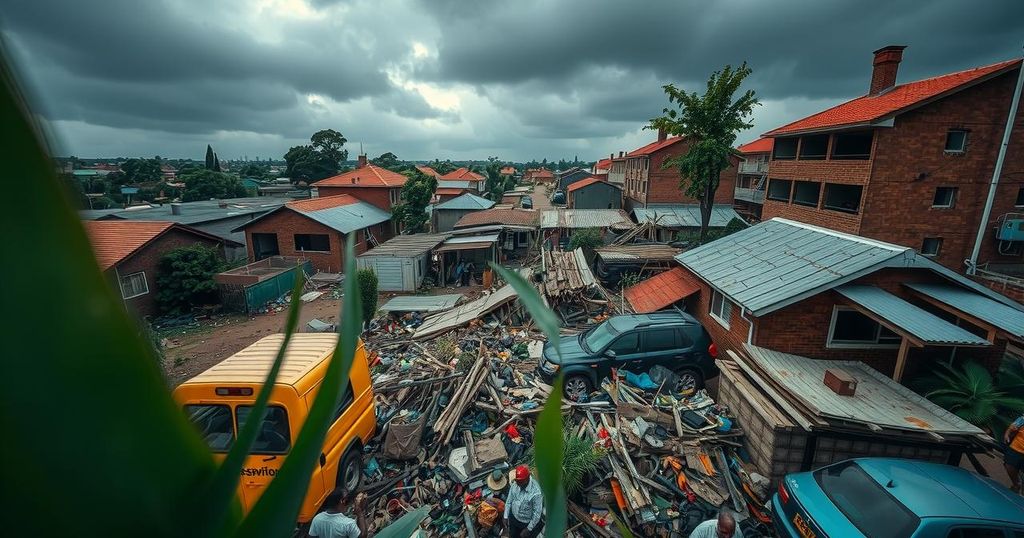Zimbabwe’s Recovery Journey Post-Cyclone Idai: A Testament to Resilience and Hope
After Cyclone Idai’s devastation in 2019, CARE has aided over 300,000 affected individuals in Zimbabwe through various recovery programs. Mwaedza’s journey highlights the impact of CARE’s shelter project, which not only provides physical safety but also inspires hope for a better future post-disaster.
In the aftermath of Cyclone Idai, CARE has extended vital assistance to over 300,000 people affected by the disaster in Zimbabwe. The cyclone struck in March 2019, claiming over 340 lives and displacing nearly 60,000 individuals, with damages estimated at around $622 million. Survivors such as Mwaedza, who lost her home and had to navigate extreme hardships, now find hope through initiatives designed to facilitate recovery and resilience in affected communities.
Mwaedza, aged 65, recounts the harrowing experience of the night Cyclone Idai wreaked havoc in her village. Forced to evacuate and seek refuge at her ancestral home, she faced immense challenges, including a lack of shelter for her family and the constant dread of severe weather conditions. Her living situation required her to secure a makeshift dwelling where even basic comforts were scarce.
As part of CARE’s efforts to help with rebuilding, Mwaedza has benefitted from a shelter project initiated in early 2024, aimed at enhancing preparedness in disaster-prone areas. The project equips communities with innovative shelter solutions and supports those who were most impacted. Mwaedza expressed her overwhelming joy upon learning about the new house being constructed for her, signifying a profound transformation in her living conditions.
This initiative, funded by the Volant Charitable Trust, highlights the collaboration between CARE and the Zimbabwean government to address existing gaps in disaster management. Mwaedza’s elation is rooted in the stability and safety her new home promises, which not only alleviates her fears during the rainy season but offers a stable environment for her family.
Although Mwaedza’s previous life was marred by loss, the support she has received allows her to envision a brighter future for herself and her grandchildren, free from the detrimental impacts of natural disasters. She recognizes that the new house symbolizes a new chapter full of hope, demonstrating the resilience and strength of communities in overcoming adversity.
Looking ahead, Mwaedza emphasizes that her home is more than a physical structure; it serves as a beacon of hope. CARE’s initiatives aim not only to rebuild but to empower families to regain independence and stability. Mwaedza’s journey showcases the importance of adequate resources for disaster preparedness, highlighting the need for ongoing support to safeguard vulnerable populations.
Walter Mwasaa, Interim Country Director for CARE Zimbabwe, underscores that the welfare of families like Mwaedza’s is crucial. The challenges faced by many across the region necessitate continued action and funding to ensure adequate shelter and provisions for those still at risk. Despite the remnants of fear caused by Cyclone Idai, Mwaedza stands ready to face future storms with renewed resilience and determination.
Cyclone Idai struck eastern Zimbabwe in March 2019, causing catastrophic destruction, loss of life, and widespread displacement. The disaster prompted significant humanitarian responses to support recovery efforts and rebuild affected communities. Organizations such as CARE have initiated projects aimed at enhancing shelter preparedness, resilience, and offering livelihoods support for those impacted by such natural disasters. This initiative highlights the essential nature of collaborative efforts between non-profits and government entities to strengthen the infrastructure and safety nets necessary for communities vulnerable to climate-related challenges.
Mwaedza’s story reflects the transformative impact of CARE’s recovery initiatives in the wake of Cyclone Idai. While the cyclone drastically altered the lives of many, it has also led to significant developments in disaster preparedness and community support systems. The emphasis on providing safe shelter underscores a broader commitment to enhancing resilience and enabling families to thrive despite the challenges posed by natural disasters. Ensuring continued funding and innovative solutions is imperative for safeguarding vulnerable populations against future adversities.
Original Source: www.care.org




Post Comment